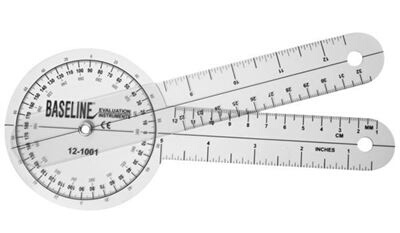The term goniometer is derived from two Greek words, gonia, meaning “angle” and metron, meaning “measurement”. A goniometer is used by physiotherapists and other health professionals to measure initial and subsequent range of motion. Movement may be active, passive or active assisted.
The first known description of a goniometer, based on the astrolabe, was by Gemma Frisius a Dutch physician, mathematician, cartographer, philosopher, and instrument maker in 1538.
There are several types of goniometer. The universal goniometer comprises a stationary arm, a movable arm, and a body with a fulcrum. The body is marked at one-degree intervals to 180 degrees or 360 degrees. Gravity goniometers measure joint range with reference to the line of gravity. Electrogoniometers, where potentiometers, strain gauges or accelerometers detect change in position of two body segments allow electrical signals to be recorded direct to computer. More recently applications on mobile phones that have been developed to measure range of movement. The accelerometers in the ‘phone are used to calculate angles.
Goniometric measures have been shown to be more reliable than visual estimation and intra-tester higher that inter-tester reliability (Brosseau et al, 2001). There is an increasing range of peer reviewed publications comparing the reliability of measurements made with smartphone applications and the universal goniometer for example, Milanese et al, 2014; Jones et al, 2015; Mourcou et al, 2015; Ockenden & Gilbert, 2012 and Otter et al, 2015.
Description provided by Catherine Sykes of Australia

